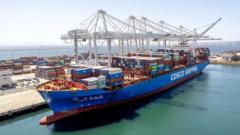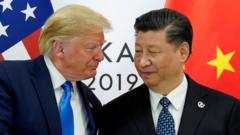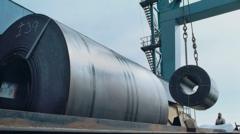The U.S. Trade Representative announced plans to implement port fees on Chinese vessels as part of an initiative to revive domestic shipbuilding and counter China's industry hegemony. While the measures come amid escalating trade tensions, experts warn of potential disruptions to global trade and rising costs for U.S. consumers.
US Targets Chinese Shipping with New Port Fees

US Targets Chinese Shipping with New Port Fees
The Trump administration's latest measure to curb Chinese shipping aims to boost American shipbuilding and alter trade dynamics.
The Trump administration is rolling out a plan to impose fees on Chinese vessels at American ports, aiming to challenge the established dominance of China's shipping industry and stimulate U.S. shipbuilding. This initiative, revealed by the U.S. Trade Representative (USTR), is deemed less aggressive than a prior proposal made in February, which suggested charges as high as $1.5 million (£1.1 million) per port visit for Chinese ships.
Set to take effect in 180 days, the fee structure will increase annually, raising concerns about its potential impact on global trade as U.S. tariffs contribute to ongoing uncertainties. According to the USTR's statement, "China has largely achieved its dominance goals, severely disadvantaging U.S. companies, workers, and the U.S. economy."
The surcharges on Chinese ship owners, with costs determined by cargo weight, container count, or vehicle numbers onboard, will start at $50 per ton for bulk vessels and increase by $30 per ton each year for three years. For container ships, fees of $18 per ton or $120 per container will follow the same rising structure. Notably, non-U.S. ships transporting cars will incur charges of $150 per vehicle per voyage, with a cap of five charges a year.
Exemptions apply to those Chinese vessels transporting empty bulk exports like coal and grain, as well as ships that navigate between U.S. ports or those servicing Caribbean islands and U.S. territories. Intriguingly, the USTR removed earlier considerations to impose fees based on the number of Chinese-built ships within an operator's fleet.
Looking ahead, a second phase of actions is planned, aimed at incentivizing the use of U.S.-built vessels for transporting liquefied natural gas (LNG), to be progressively enforced over the next 22 years.
The announcement coincides with existing disruptions to global trade, fueled by President Trump’s import tariffs that have redirected cargo originally bound for the U.S. to European ports. Experts indicate that these changes have resulted in raised costs for American consumers.
In the early months of 2025, Chinese imports to the UK surged by approximately 15%, with the EU seeing a 12% increase—trends attributed to the shifting landscape of U.S.-China trade relations. Analysts caution that, as U.S. tariffs climb to potentially 245% on selected Chinese goods, congestion is growing at both European and UK ports, creating significant delays and impacting overall trade stability.
Logistics expert Sanne Manders echoed these concerns, noting that current port congestion—particularly in the UK’s Felixstowe and ports across mainland Europe—has become acute, further complicated by labor strikes in key regions. As companies adapt to new market realities, U.S. consumers are expected to bear the increased financial burden spurred by tariffs, while their European counterparts may remain relatively insulated from the immediate effects.






















